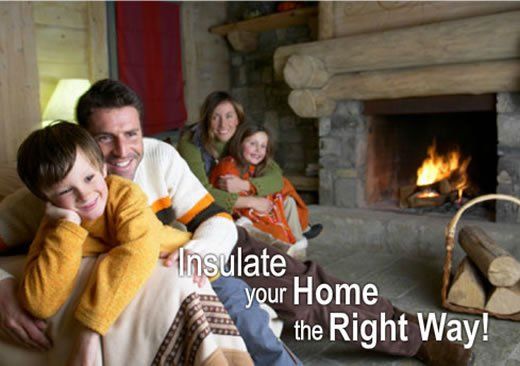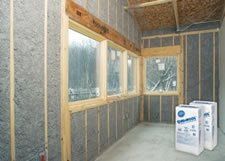Cellulose Insulation: a Wise Choice Compared to Fiberglass
The Natural Choice for High Performance Green Building

Consumers and builders have many choices when it comes to what type of insulation to use in their new home. Cellulose Insullation , fiberglass, and foam insulations are the most readily available options. Insulation decisions are typically based on performance, value, and environmental aspects. Your insulation choice not only includes its thermal performance (R-Value), but should also include its fire resistance, sound blocking capability and resistance to mold, insects, and vermin. In terms of thermal performance, R-value is not always the best indicator of how the insulation will perform in your home. R-values are measured in the laboratory and don’t take into account the effects of wind and pressure differences within the home caused by the height of the home (Stack Effect), and mechanical systems such as dryers, range hoods, and heating and cooling equipment. When these pressures are coupled with the fact that homes are built from thousands of pieces, all with edges joints and gaps (also known as holes!), it means that air will try to move through and around your insulation. Insulation works by trapping air between its fibers or pores. It is this trapped air and not the wood or glass fiber that provides the resistance to heat flow. When air flows through or around your insulation, your insulation loses its effectiveness, leading to an uncomfortable home and high fuel bills. Conventional fiberglass performs poorly, since air moves through it very easily, and it has unsealed edges and gaps no matter how well it is installed. Cellulose insulation , whether it is sprayed into a wall assembly or injected dry, i.e., ‘dense packed’, at densities of 3.5 pounds of material per cubic foot (lbs/cf), blocks air movement and leaves no gaps or joints for air to flow through. This means that cellulose delivers a consistent performance of R 3.8 per inch for cellulose. At these high densities, the cellulose insulation will also remain stable and in place, with no settling, for the life of the structure. The other reason for blocking air movement is that air accounts for over 98% of moisture movement in a structure. Thus, if we block the flow of air, we eliminate the potential rot and damage, and prolong the life of the structure. But what about vapor barriers? Cellulose insulation has been installed in millions of homes and buildings successfully since the 1920’s without vapor barriers. The hygroscopic nature of the cellulose means that any moisture entering is dispersed and slowly diffuses through the material without accumulation or damage, protecting both the insulation and the surrounding materials. Fiberglass insulation has no moisture storage capacity. Moisture easily passes through fiberglass, condensing on the interior or exterior sheathing (depending on the season), causing deterioration of the structure. The hydrophobic properties of foam are very protective to the material, but offer no protection to the surrounding materials.
A house fire is something we all want to avoid. In terms of fire resistance, cellulose insulation is superior to other insulation options. Laboratory testing has shown that 14.5 inches of cellulose outperforms wood fire blocking. The boric acid fire retardants prevent flames from traveling through the cellulose and enhance the fire resistance of any assembly that cellulose is used in. Fiberglass insulation doesn’t burn, but it melts when exposed to flame, allowing fire to spread vertically very quickly. Foam insulation burns when exposed to fire and releases large quantities of toxic smoke. The borate based fire retardants used in cellulose insulation also help discourage mold, insects and vermin. Borates are derived from naturally occurring borax and are permanently impregnated into the cellulose fibers. Fiberglass and foam insulations do not offer the same protection.

As buildings continue to be built in closer proximity and next to busy roads, the sound performance of your insulation becomes more important. Cellulose insulation offers the best sound blocking capability of any insulating material, due to its high density, air blocking ability, and vibration dampening qualities. In a 2x4 wall, cellulose achieves a sound transmission coefficient (STC) of 41, blocking out normal conversation and noise. The environmental aspects that are important in selecting your insulation include recycled content, embodied energy, and local production and manufacturing. Cellulose insulation is made from recycled newspaper and has a recycled content of over 82%. Fiberglass may have up to 35% recycled glass and foam insulation between 0 to 9% recycled content to its petrochemical formulation. The amount of energy that it takes to manufacture the insulation (embodied energy) also varies widely. Cellulose insulation is produced in regional manufacturing facilities using 750 Btu/lb of material produced. Fiberglass takes 12,000 Btu/lb to heat and process the glass, while foam insulation uses 30,000 to 48,000 Btu/lb to manufacture from petroleum based chemicals. Both are produced in large, centralized manufacturing plants. The value of your insulation depends not only on your initial price, but also on what your insulation choice will cost over a period of time in heating and cooling bills. Fiberglass has the lowest initial price, but it will end up costing much more over time in higher heating and cooling bills and reduced comfort. Foam insulation has good thermal performance, but it has a much higher initial cost compared to the other options. Foam also has limitations in terms of sound attenuation and smoke production in the event of a fire, and is not the most environmental choice you can make. The cost of cellulose insulation typically falls between fiberglass and foam, while exceeding both of them in terms of performance and environmental friendliness. Cellulose insulation is not only the green choice, but it is also the best choice when performance and comfort are desired.
For more information about Cellulose Insulation please contact us at Tanguay Homes in Newport, Vermont.
http://www.nationalfiber.com/docs/NationalFiberCelluloseTheNaturalChoiceForGreenBuilding0909.pdf
